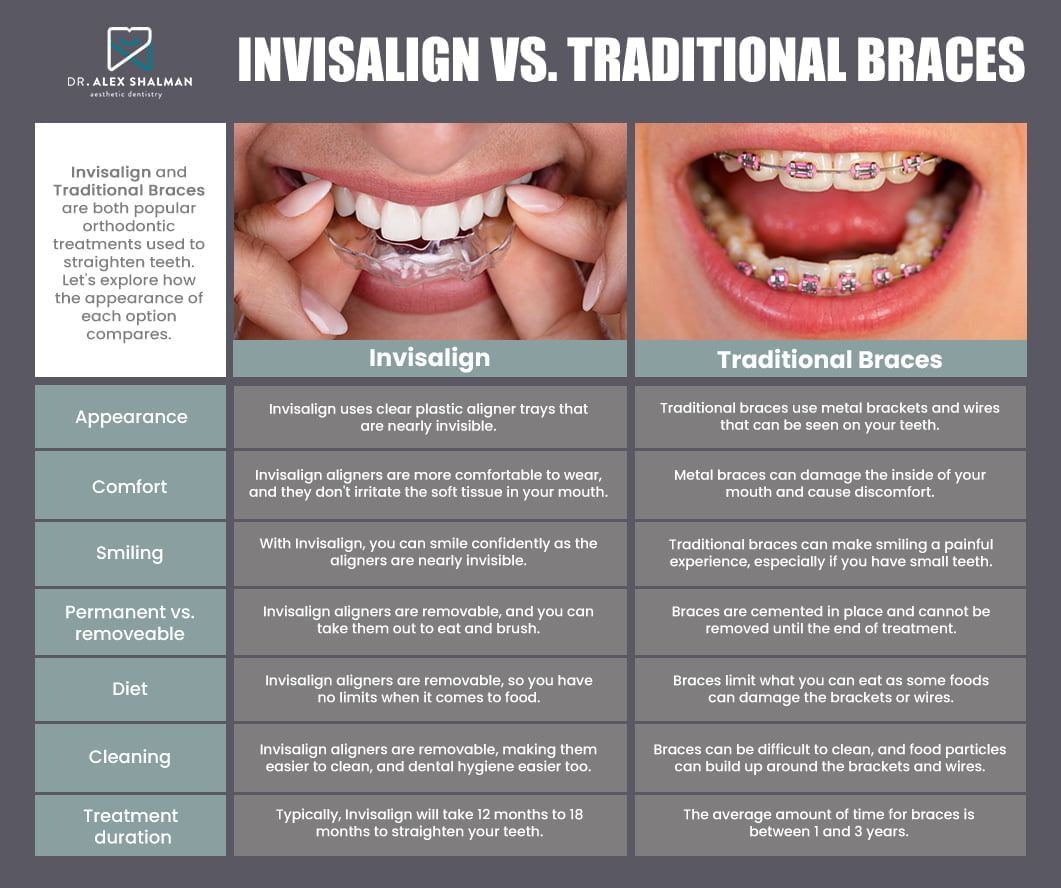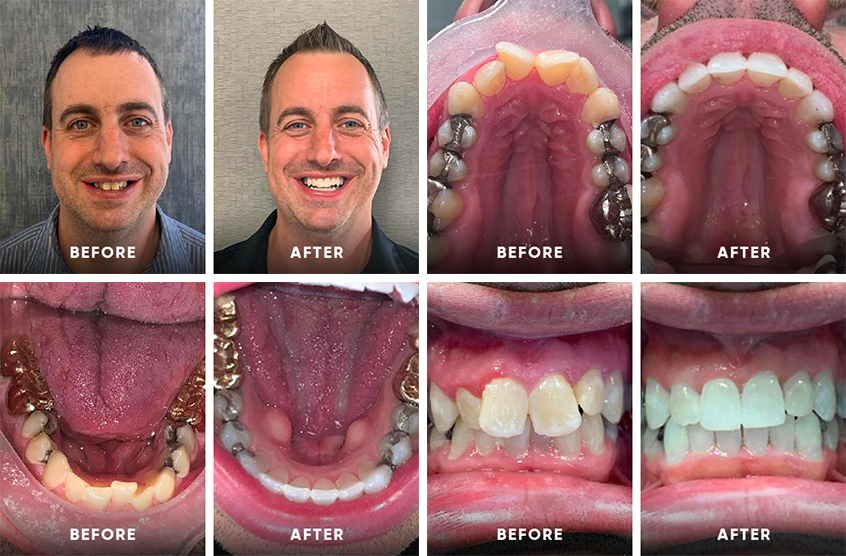Success Stories: How Invisalign Changed Lives and Enhanced Confidence
Success Stories: How Invisalign Changed Lives and Enhanced Confidence
Blog Article
Invisalign vs. Standard Dental braces: Which Alternative Is Right for You?
When taking into consideration orthodontic therapy, the option in between Invisalign and conventional braces provides several vital elements that warrant cautious examination. Invisalign offers a very discreet choice with removable aligners, while typical braces give a more visible yet reliable service for serious imbalance. Each alternative includes unique advantages and disadvantages connected to aesthetics, convenience, treatment period, and expense. Recognizing these nuances is essential for making a notified decision that aligns with your personal choices and lifestyle. The question remains: which option will best meet your orthodontic demands and expectations?
Review of Therapy Alternatives

On the other hand, typical dental braces contain steel braces and wires that are bonded to the teeth. This technique applies constant stress with time to attain placement. While effective for complex orthodontic problems, traditional braces require regular visits for adjustments and can present challenges in keeping oral health as a result of the difficulty of cleansing around braces and cords.
Both choices have their advantages, and the option often pivots on specific dental conditions, way of life choices, and person conformity. Inevitably, getting in touch with an orthodontic specialist is crucial for establishing one of the most appropriate therapy plan customized to individual requirements. Understanding the nuances of each choice can dramatically affect the general success of orthodontic therapy.
Visual Considerations
A substantial factor affecting the option in between Invisalign and typical dental braces is the visual charm each therapy uses. Invisalign aligners are crafted from clear plastic, making them essentially undetectable when worn.
In contrast, typical braces are composed of metal brackets and cords, which can be much more visible. While innovations in orthodontic technology have actually caused the advancement of smaller braces and colored elastics, conventional dental braces still maintain an even more noticeable account. For some people, the exposure of braces might discourage them from seeking required treatment.
Ultimately, the option between Invisalign and conventional dental braces might depend upon personal choices concerning looks. People that focus on discretion frequently lean towards Invisalign, while those who are less worried concerning exposure may decide for traditional dental braces. Recognizing the aesthetic ramifications of each choice is important for making an educated choice that straightens with one's way of living and choices.
Comfort and Convenience

In regards to comfort, Invisalign aligners are removable, allowing people to appreciate their favorite foods without restriction and preserve optimal dental health. Cleaning and flossing are streamlined, as the aligners can be secured during these regimens, whereas conventional braces need cautious maneuvering around brackets and cords.
Furthermore, Invisalign's modern system permits for fewer orthodontic check outs. People typically get multiple sets of aligners simultaneously, which can enhance the treatment process and reduce time spent in the orthodontist's chair. In contrast, conventional braces demand routine modifications, making them much less practical for those with active routines. Invisalign. On the whole, the convenience and comfort of Invisalign make it an enticing option for many people seeking orthodontic therapy.
Treatment Duration and Performance
While both Invisalign and traditional dental braces work in dealing with oral imbalances, the period of therapy can vary substantially in between both options. Generally, Invisalign treatment can take anywhere from 12 to 18 months, depending on the intricacy of the instance. The clear aligners work by progressively moving teeth right into their preferred positions, and routine follow-ups with an orthodontist help guarantee progression remains on the right track.
On the other hand, conventional dental braces commonly need a longer dedication, normally ranging from 18 months to three years. This is due to their set nature and the usage of brackets and find out here cords, which can be much more reliable for extreme misalignments and complicated cases (Invisalign). The treatment efficiency of conventional dental braces is well-documented, as they allow for precise changes and greater control over tooth activity
Eventually, the choice between Invisalign and typical braces may depend upon both the awaited treatment duration and the certain dental concerns at hand. Consulting with an orthodontist is critical, as they can supply customized suggestions based on private demands, ensuring the picked approach straightens with wanted outcomes and timeframes.
Cost Comparison and Insurance Coverage Options
Expense plays a significant role in the decision-making process More Info for individuals thinking about orthodontic treatment, whether choosing Invisalign or traditional dental braces. Typically, the cost of Invisalign arrays from $3,000 to $8,000, while conventional braces generally cost between $2,000 and $6,000. Variables influencing these prices consist of the complexity of the instance, the duration of treatment, and geographical place.
Lots of dental insurance policy strategies give partial coverage for orthodontic treatments, however the specifics can differ commonly. Generally, conventional braces may be more regularly covered by insurance policy strategies contrasted to Invisalign, which some insurance firms classify as a cosmetic procedure.
Additionally, numerous orthodontic methods offer versatile layaway plan, making both therapy options extra available. Individuals should ask about possible funding choices and discount rates for in advance repayments. Examining the total cost, including insurance advantages and payment plans, is important for making a notified decision that lines up with both aesthetic preferences and budget plan factors to consider.

Conclusion
In recap, the choice between Invisalign and conventional braces rests on numerous elements, including aesthetic preferences, comfort, therapy period, and price. Invisalign provides a very discreet, removable alternative that helps with dental health and dietary versatility, while standard braces might be better for intricate dental issues and typically come with a lower cost factor. Ultimately, examination with an orthodontist is important to analyze specific situations and figure out one of the most ideal therapy choice for achieving optimum oral alignment.
When taking into consideration orthodontic therapy, the selection between Invisalign and conventional braces provides numerous essential elements that merit careful examination.Contrasting Invisalign and typical braces reveals distinctive therapy options for orthodontic improvement.While both Invisalign and standard braces are reliable in correcting oral misalignments, the duration of treatment can vary considerably in between the two choices.Cost plays a considerable duty in the decision-making procedure for individuals thinking about orthodontic treatment, whether deciding for Invisalign or typical dental braces.In summary, the option in between Invisalign and traditional braces pivots on multiple factors, consisting of navigate here visual choices, convenience, treatment duration, and price.
Report this page